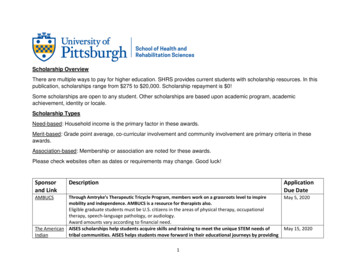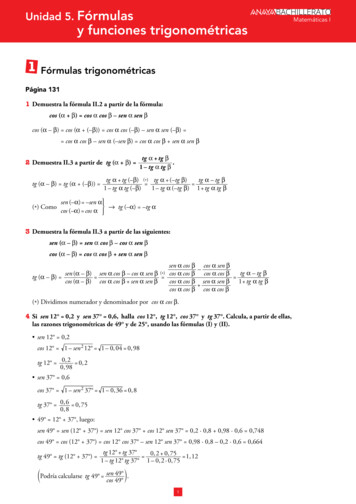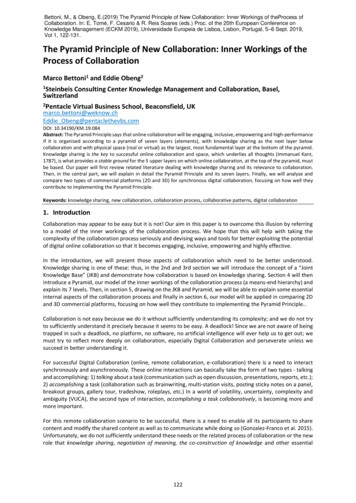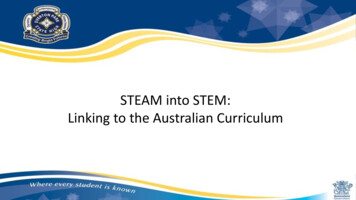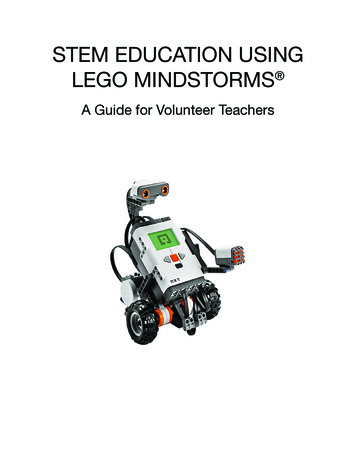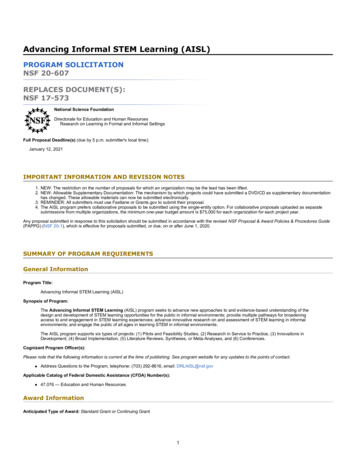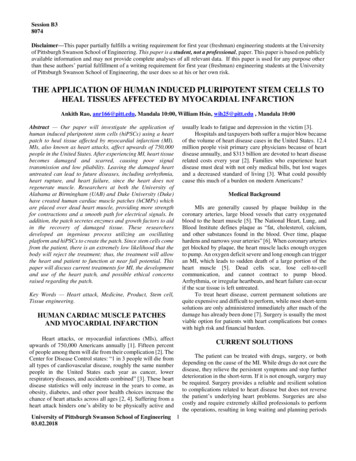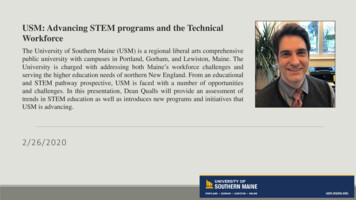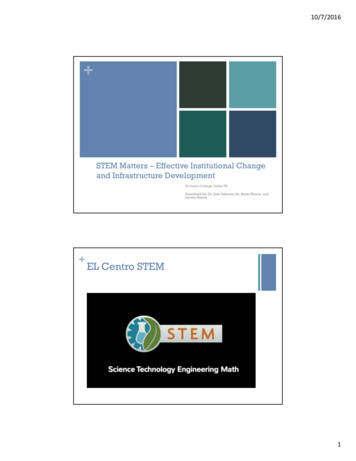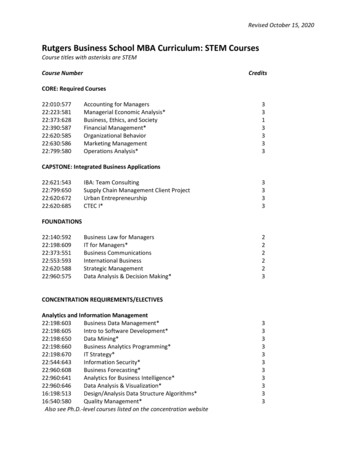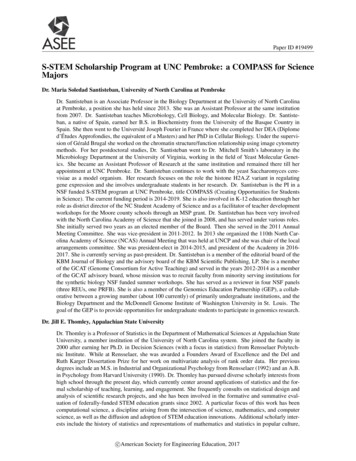
Transcription
Paper ID #19499S-STEM Scholarship Program at UNC Pembroke: a COMPASS for ScienceMajorsDr. Maria Soledad Santisteban, University of North Carolina at PembrokeDr. Santisteban is an Associate Professor in the Biology Department at the University of North Carolinaat Pembroke, a position she has held since 2013. She was an Assistant Professor at the same institutionfrom 2007. Dr. Santisteban teaches Microbiology, Cell Biology, and Molecular Biology. Dr. Santisteban, a native of Spain, earned her B.S. in Biochemistry from the University of the Basque Country inSpain. She then went to the Université Joseph Fourier in France where she completed her DEA (Diplomed’Études Approfondies, the equivalent of a Masters) and her PhD in Cellular Biology. Under the supervision of Gérald Brugal she worked on the chromatin structure/function relationship using image cytometrymethods. For her postdoctoral studies, Dr. Santisteban went to Dr. Mitchell Smith’s laboratory in theMicrobiology Department at the University of Virginia, working in the field of Yeast Molecular Genetics. She became an Assistant Professor of Research at the same institution and remained there till herappointment at UNC Pembroke. Dr. Santisteban continues to work with the yeast Saccharomyces cerevisiae as a model organism. Her research focuses on the role the histone H2A.Z variant in regulatinggene expression and she involves undergraduate students in her research. Dr. Santisteban is the PI in aNSF funded S-STEM program at UNC Pembroke, title COMPASS (Creating Opportunities for Studentsin Science). The current funding period is 2014-2019. She is also involved in K-12 education through herrole as district director of the NC Student Academy of Science and as a facilitator of teacher developmentworkshops for the Moore county schools through an MSP grant. Dr. Santisteban has been very involvedwith the North Carolina Academy of Science that she joined in 2008, and has served under various roles.She initially served two years as an elected member of the Board. Then she served in the 2011 AnnualMeeting Committee. She was vice-president in 2011-2012. In 2013 she organized the 110th North Carolina Academy of Science (NCAS) Annual Meeting that was held at UNCP and she was chair of the localarrangements committee. She was president-elect in 2014-2015, and president of the Academy in 20162017. She is currently serving as past-president. Dr. Santisteban is a member of the editorial board of theKBM Journal of Biology and the advisory board of the KBM Scientific Publishing, LP. She is a memberof the GCAT (Genome Consortium for Active Teaching) and served in the years 2012-2014 as a memberof the GCAT advisory board, whose mission was to recruit faculty from minority serving institutions forthe synthetic biology NSF funded summer workshops. She has served as a reviewer in four NSF panels(three REUs, one PRFB). She is also a member of the Genomics Education Partnership (GEP), a collaborative between a growing number (about 100 currently) of primarily undergraduate institutions, and theBiology Department and the McDonnell Genome Institute of Washington University in St. Louis. Thegoal of the GEP is to provide opportunities for undergraduate students to participate in genomics research.Dr. Jill E. Thomley, Appalachian State UniversityDr. Thomley is a Professor of Statistics in the Department of Mathematical Sciences at Appalachian StateUniversity, a member institution of the University of North Carolina system. She joined the faculty in2000 after earning her Ph.D. in Decision Sciences (with a focus in statistics) from Rensselaer Polytechnic Institute. While at Rensselaer, she was awarded a Founders Award of Excellence and the Del andRuth Karger Dissertation Prize for her work on multivariate analysis of rank order data. Her previousdegrees include an M.S. in Industrial and Organizational Psychology from Rensselaer (1992) and an A.B.in Psychology from Harvard University (1990). Dr. Thomley has pursued diverse scholarly interests fromhigh school through the present day, which currently center around applications of statistics and the formal scholarship of teaching, learning, and engagement. She frequently consults on statistical design andanalysis of scientific research projects, and she has been involved in the formative and summative evaluation of federally-funded STEM education grants since 2002. A particular focus of this work has beencomputational science, a discipline arising from the intersection of science, mathematics, and computerscience, as well as the diffusion and adoption of STEM education innovations. Additional scholarly interests include the history of statistics and representations of mathematics and statistics in popular culture,c American Society for Engineering Education, 2017
Paper ID #19499particularly mathematically talented women. Her co-edited work The Encyclopedia of Mathematics andSociety (3 volumes) was named a ”Best Reference 2011” by the editors of the well-respected LibraryJournal. She is also the proud co-creator of the Girl Scout Women in Mathematics Merit Badge program,which introduces middle school girls to the beautiful diversity of mathematics and women who work inthe discipline, as well as the opportunities that exist today for girls and women who want to pursue careersin mathematics.Dr. Rebecca Bullard-Dillard,Dr. Rebecca Bullard Dillard is the current Associate Vice Chancellor for Research and Sponsored Programs at the University of North Carolina Pembroke (UNCP), having been recruited in 2013. Dr. BullardDillard earned her B.S. degree in Biochemistry at North Carolina State University in 1990, then her Ph.D.from the University of South Carolina Department of Chemistry in 1996. Dr. Bullard-Dillard, a proteinbiochemist, previously served as the biology department chair, then in increasing levels of responsibilityin research administration, at Claflin University from 1999 – 2013. In 2007, she helped formed a workinggroup whose purpose was to bring alternative energy research and infrastructure to South Carolina. Collaborative efforts with several energy sector private industry partners were established as well as workinggroups with city, state and federal agencies. These projects resulted in a patent in bioenergy (US Patent:US20146657327). Now, in her role as chief research officer, Dr. Bullard-Dillard has brought that resourcenetwork to the task of research infrastructure building for UNCP. Dr. Bullard-Dillard has been recognizedthrough her Outstanding Alumni Award from North Carolina State University College of Agricultureand Life Sciences, her South Carolina Governor’s Award for Excellence in Scientific Awareness and herSouth Carolina Independent Colleges and University’s Excellence in Teaching Award among others. Sheis deeply committed to her work in education and research to assure that the United States’ scientificcommunity continues to lead the world in solving the complex problems that challenge our future.c American Society for Engineering Education, 2017
S-STEM Scholarship Program at UNC Pembroke:A COMPASS for Science Majors
IntroductionIn the United Stated, educating students and creating leaders in science, technology, engineeringand mathematics (STEM) is a growing priority and viewed by many as the key to 21st centuryglobal competitiveness. In 2013, the White House National Science and Technology Councilreleased an ambitious five-year STEM Strategic Plan to coordinate federal investments in STEMeducation targeting five priority areas.1 One of these is graduating one million additional studentswith STEM degrees over the next ten years. Another is increasing the number of students fromgroups currently underrepresented in STEM disciplines.Universities are rising to meet the challenge of producing more STEM-educated students. TheUniversity of North Carolina at Pembroke (UNCP) is poised to contribute positively to the needfor diverse STEM professionals. UNCP already has high quality STEM programs, its STEMenrollment has steadily increased over the last five years, and the university has maintained anoverall enrollment of 54% underrepresented minorities (URM). However, despite its advantages,the STEM graduation rate has been low. Attrition is a concern; just under half (48%) of freshmenwho declare a STEM major persist to their senior year. These students also take more time tofinish. Only 18.7% of STEM majors graduate in four years. Spurred by these issues, STEMfaculty designed the “Creating Opportunities for Students in Science (COMPASS) ScholarshipProgram” to improve STEM retention and align with the STEM Strategic Plan. A grant from theNational Science Foundation (NSF) provided funds to recruit 27 talented but financially needyundergraduates in Biology, Biotechnology, Chemistry, and Environmental Science. COMPASSsupports these students through a combination of mentoring, financial support, tutoring, research,internships, and professional development in order to improve their educational experiences.This should in turn produce better retention and graduation rates. At the time of the COMPASSprogram’s conception, the UNCP student body of about 6400 students, mostly undergraduates,had 54% URM and 50% were first generation students.2 The program planned to target thesegroups preferentially. UNCP also had a large pool of high-talent, financially needy students whowould benefit significantly. For example, 58% received Pell grants. COMPASS enrolled studentsin three cohorts over three years, beginning in Fall 2014. The goal was for 100% of scholars togo on to graduate school or STEM careers within six years. The program creators predicted thatCOMPASS would increase the number of STEM professionals in this rural region of NC, whosediverse background should result in enhanced innovation in STEM fields. Two and a half yearinto the program, we report strong progress towards our goals and some valuable lessons learnedtoward improving our successes and the efforts of other who might plan a similar innovation.The Need for Programs like COMPASS: Preparation and Financial BurdenEconomic projections estimate that, in the next decade, the U.S. will need about one millionadditional STEM professionals, beyond current graduation rates.3-5 Employment projections for2018 state that 68% of STEM jobs will require bachelor’s degree or higher.6 In North Carolina,STEM jobs are expected to increase by the national average of 17%.7 However, the U.S. isfailing to keep pace in producing a qualified STEM workforce. Only 1 in 5 high school graduateswho score in the top quartile in mathematics pursues a STEM profession6 and 19% of bachelor’sdegrees are earned in STEM fields, compared to 50% in China.8 Poor retention and graduationrates among undergraduate STEM majors are major concerns.1 Of students entering as a STEM
major in a four-year public college or university, only 43% persist to graduation in those fields.Retention is even more alarming for underrepresented minorities (URM), who are about 40% ofU.S. K-12 students but earn only 27% of all associate’s degrees, 17% of bachelor’s degrees innatural sciences and engineering, and 6.6% of doctorates in those fields.9, 10The University of North Carolina at Pembroke (UNCP), located in rural southeastern NorthCarolina, serves a primarily undergraduate (87.8%) student body. The vast majority of UNCPstudents (96.4%) come from within North Carolina. It was established as Croatan Normal Schoolin 1887, with the goal of training Native American teachers. At the time the COMPASS programwas conceived, 16.2 % of student were Native American, 32% African-American, 4% Hispanic,1.5% Asian, and 2% two or more races (54% total URM). Today those figures are very similar,with 59% total URM. In addition, 88% of all students at UNCP received some form of financialaid and 58% qualified for Pell grants in 2010-2011. The student body demographics of UNCP’sput the institution at risk for poor retention and graduation of STEM majors. At the same time,there is a rich pool of students available to increase the diversity of the STEM community.Table 1 UNCP STEM Enrollment and Degrees Conferred in 2008 and 2012, with % of URMBiologyBiotechnologyEnvironmental ScienceChemistryTotalGrowthEnrollment inEnrollment inFall 2008Fall 2012375 (55%)458 (58%)15 (73%)16 (53%)23 (30%)37 (29%)143 (52%)188 (60%)556 (54%)699 (57%) 26% EnrollmentDegrees inDegrees inAY 2008AY 201249 (53%)74 (51%)2 (0%)0 (0%)6 (17%)6 (0%)25 (40%)25 (44 %)82 (45%)105 (46%) 28% Degrees ConferredTable 1 shows STEM enrollment and degrees conferred in 2008 and 2012 at UNCP for the fourmajors that are the focus of the COMPASS program. These four majors share substantial coursecontent and accounted for 83% of all STEM students in 2012. The other STEM majors at UNCPinclude computer science, mathematics, and physics. The proportion of URM students in thesemajors is consistent with representation on campus in enrollment and degrees conferred. TotalSTEM enrollment increased 20% over this five-year period and graduation increased 17%.Among UNCP STEM freshmen, fewer than half (48%) remain by senior year and only 18.7%graduate in four years. Nationally, lack of college readiness is a major culprit in low graduationrates.11, 12 At UNCP, a 2011 survey also identified poor preparation as one important obstacle tochoosing or graduating in a STEM field.13 Other challenges cited were perceptions that STEMcontent is too difficult, lack of understanding of career opportunities, and financial hardship.The US Census Bureau (2010) ranked UNCP’s Robeson County as the poorest county in NC andone of the 250 poorest in the nation. About 34% of UNCP students come from Robeson County,and in 2011, 81% of them reported a family income of less than 75,000 (with 30.5% less than 30,000)2. Thus, UNCP’s students are severely financially disadvantaged. Low-income studentsare more likely to leave college.14 UNCP recommends that full-time students not work more than20 hours per week. In 2011 survey, 14.1% of freshman students planned to work more than 20hours/week and 25.8% planned to work 20 hours or less.2 Even so, UNCP dropped 511 students
in fall 2011 for non-payment. About 38% owed 2001- 3000, while 9% owed over 5,000. In arecent exit questionnaire for withdrawing from school, 27% cited financial reasons.Of the 699 STEM students in Table 1, 379 had Pell grants and 487 had loans. Despite assistance,there was a severe unmet financial need. In 2013, the in-state cost of attendance at UNCP was 16,397 and average financial aid received was 10,910, resulting in an average unmet financialneed of 5,487. COMPASS planners projected that an average of 6,000/year per student wouldbe required to bridge that gap.COMPASS Project Objectives and PhilosophyThe goals of the COMPASS program are:1. Recruit 27 motivated, academically talented, and financially needy Biology, Biotechnology,Environmental Science, and Chemistry majors at UNCP, including underrepresentedminorities (URM) and first generation students, and provide them with financial assistance.2. Improve STEM education experiences for all of the recruited students and prepare them forthe STEM workforce or graduate/professional programs. The intention was that 100% ofscholars would graduate with a STEM degree in less than six years.Program Recruitment and DemographicsThe first year of recruitment was conducted in spring semester only because of the award datefrom the National Science Foundation. The principle investigator posted flyers on campus andvisited introductory science classes, while other professors made announcements in their classes.The Biology Department hosted a COMPASS web page, with additional links in Chemistry andAdmissions/Financial Aid. Rising sophomores in the four targeted majors with a 3.0-4.0 GPAafter one semester at UNCP received a direct email. Analysis of the student body had previouslyindicated that the potential pool should be large enough to recruit nine students per year. Forexample, of 178 freshmen in the four COMPASS majors in fall 2012, 45 had a 3.0-4.0 GPA. Ofthis group, 51% were on Pell grants, 51% had federal loans, 73% had personal loans, and 89%had some other financial aid. Only one student received no financial support. E-mails and flyersalso were sent to local community colleges.After the first year, COMPASS scholars participated in recruitment efforts and visited freshmanseminar sections, which all freshmen and any transfer student with less than 30 hours must attendin the fall semester. A promotional video produced in the fall of the first year was shown duringspring visits to introductory science classes, or by course professors in some cases.The COMPASS program currently has three cohorts of 8, 9, and 10 students. One student fromCohort 1 left in the first semester due to family relocation to another state. He was replaced witha student of the same class year, who has been thriving. A second student from Cohort 1 left forpersonal reasons after two years. A new student of the same class year would have had only oneyear in the program rather than three. We instead enrolled 10 students in Cohort 3 in Fall 2016.Unfortunately, one student decided to change to a non-STEM major. A replacement was enrolled
at the beginning of Spring 2017. Tables 2 and 3 show scholar demographics and ethnicities. Theprogram has successfully recruited women and URM.Table 2. Demographics of COMPASS Chemistry22 (81%)5 (19%)14 (52%)3 (11%)8 (30%)Double Major2 (7%)Table 3. Ethnicity of COMPASS scholars.Cohort 1Cohort 2Cohort an/Filipino1001Hispanic0112URMTotal6 (75%)6 (67%)8 (80%)20 (74%)WhiteTotal2 (25%)3 (33%)2 (20%)7 (26%)891027Student Activities, Services and ProgramsFinancial support is one of the pillars of the program. COMPASS was designed to support threecohorts of 9 students from their sophomore year through graduation by awarding a cumulative 81annual scholarships totaling 486,000. In each year of the project, up to four students can receivean additional 2,100 of summer support if they participate in a research experience or internshipand the site they attended does not provide a stipend.The other three program pillars are academic support, career support, and community support(including creating a community of scholars). The COMPASS program uses several strategies,balanced on these pillars, to ensure success and sustainability. First, it leverages existing UNCPprograms such as career services, recruitment, and financial aid. Second, it explicitly builds acommunity of scholars who receive continuous support. Third, it develops career connectionswith regional industry. The key to accomplishing the critical support and community buildingoutcomes is a coordinated program of intensive mentoring and tutoring, research opportunitiesand experiences, internships, professional development, and both academic and career advising.Building an inclusive learning community of STEM scholars also strengthens the institutionalculture for other students at UNCP to want to excel and be part of this community. Success relieson a strong team approach, including the two principle investigators and nine STEM faculty.Many elements, such as tutoring, are already available to all UNCP STEM majors. However, theCOMPASS program has expanded on these offerings to provide unique added benefits.Financial SupportMany UNCP students must work or drop out for financial reasons. Research14 has shown that theeffect of financial aid on retention in the first year may have a threshold, whereas any amount offinancial aid in years two and three reduced the risk of departure of recipients relative to studentswithout financial aid. Thus, the creators believed that offering financial support from sophomoreyear to graduation should be most effective for improving re
University of North Carolina at Pembroke (UNCP) is poised to contribute positively to the need for diverse STEM professionals. UNCP already has high quality STEM programs, its STEM enrollment has steadily increased over the last five years, and the university has maintained an ove
